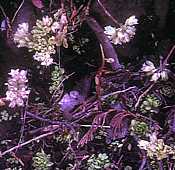Hylotelephium Ohba 1977 (Orpines)
The genus Hylotelephium currently includes about 33 species, several of which have been moved recently from Sedum, including the colourful H. telephium and H. spectabile (Autumn Joy). These hardy plants from Eastern Europe and Asia have erect stems bearing large, flat leaves with serrated margins. The inflorescence is typically a dense head of tiny pink flowers, often providing useful late Summer colour. Some species have become naturalised in North America.
|

Hylotelephium cauticola Ohba 1977 Syn. Sedum cauticola Praeger 1917
This shade-loving succulent plant has fleshy, rounded blue-green leaves on thin pink stems. The inflorescence is a panicle of small, bright pink flowers, produced in late Summer.
Native to Japan.
|

Hylotelephium ewersii Ohba 1977 (Pink Mongolian Stonecrop)
Syn. Sedum ewersii
This hardy, but deciduous succulent plant is native to mountains of central Asia and the Himalayas up to elevations of 14,000 ft. The creeping stems produces sparsely-arranged glaucous, fleshy ovate leaves and panicles of pink to red star-like flowers during the Summer.
Numerous cultivars are available with different shades of blue-green leaves and flower colours. Suitable for a sunny, well-drained position in the rock garden.
|

Hylotelephium pluricaule Ohba 1977 Syn. Sedum pluricaule
This small Sedum forms a low mound of ovate blue-green fleshy leaves flushed with pink densely arranged on short stems, offsetting clusters of pink star-like flowers in mid-Summer. Dies back to the ground in the Winter. In the Spring, new stems arise from the base of the old stems.
Cold hardy with excellent drainage or suitable for a cold frame in climates with a wet Winter. Native to the Russian island of Sakhalin in the North Pacific.
|

Hylotelephium spectabile Ohba 1977 Syn. Sedum spectabile
is a hardy, free-flowering plant providing late Summer colour. The plants die down to the ground each winter and new stems with fleshy, blue-green leaves are produced in the Spring. Each stem produces a flower head in late Summer, which is attractive to bees and butterflies at a time when other flowering plants have finished. Native to Eastern Asia, China, Korea and Japan.
Numerous Hylotelephium hybrids and cultivars are available for the garden, with a range of flower colours from white to deep red and in some cases coloured leaves in shades of purple. Stems can be pinched out in the Spring to encourage a bushier habit. The stem tips can be potted up and will quickly form roots to make new plants.
|

Hylotelephium telephium Ohba 1977 Syn. Sedum telephium
from Eurasia provides useful flower colour in the garden in late summer and early autumn. Dense heads of many tiny pink, red or white flowers are produced in late Summer and Autumn, attracting bees and butterflies. The flat buish-green leaves have serrated margins and provide a spectacular contrast to the flowers.
Distributed from Eastern Europe to China.
These tolerant plants are fully frost hardy, but the stems die down to the ground each year after flowering. New plants may be propagated from stem cuttings. If the growing stem is pinched out early in the season, it will branch to form multiple flower heads and the pinched tips can be used for propagation.
|
Phedimus Rafinesque 1817
Name: Greek phaidimos = shining, referring to the glossy leaves of some species - or
Named for: Phedimus archbishop of Amasea and Metropolitan of Pontus, ca. 235 AD.
Phedimus includes 20 species, mostly mat-forming perennials, distributed through Europe and Asia. The flowering shoots grow upright and typically produce a dense panicle of red, pink or yellow flowers. The leaves are flattened with notched margins, distinct from the thickened leaves of Sedum with entire margins. DNA analysis supports Phedimus as a distinct group.
Many Phedimus are frost-hardy and suitable for a sunny garden. Their water-retaining leaves allows them to be used as drought resistant creeping plants.
|
 |
Phedimus kamtschaticus 't Hart 1995 Syn. Sedum kamtschaticum Fischer & Meyer 1841
The oval leaves with notched margins are marginally succulent. This plant is worth growing for the clusters of relatively-large golden-yellow flowers produced in the Summer.
Native to Siberia, East China, Japan and Korea and fully hardy.
|

Phedimus spurius 't Hart 1995 Syn. Sedum spurium von Bieberstein 1808
Latin spurius = 'out of wedlock, of an unknown father' refering to species whose taxonomy was difficult
A creeping, mat-forming plant with tight rosettes formed from marginally-succulent obovate leaves with serrate margins. Flowering stems have leaves distributed along their length and bear terminal clusters of pink to red flowers.
Native to Georgia, Turkey and Iran but naturalised elsewhere in Europe. This species is commonly seen labelled as a Sedum. Selected garden varieties include dark red flowers with red-brown leaves, orange flowers, white flowers with pure green leaves and variegated forms.
|

Phedimus spurius var. albus
Syn. Sedum spurium var. album von Trautvetter 1876 |
 |

Phedimus spurius var. purpureus
Alpine planter at RBG Kew |
|
 |
Phedimus stoloniferus 't Hart 1995 Syn. Sedum stoloniferum Gmelin 1774
This creeping, mat-forming plant has small, marginally-succulent oval leaves with slightly notched margins and produces clusters of relatively large pink flowers in the Summer.
Native to a region from the Caucasus to Iran and naturalised in Europe and North America. Fully frost hardy.
|
Rhodiola Linnaeus 1753
Name: Greek rhodon = red
Plants in this genus have flowers with twice as many stamens as petals and the petals are separate or nearly so, rather than joined in a tube. Roots are rhyzomatous with flower stems arising directly from axils on the rhyzome. This is the only genus in the Family Crassulaceae that has unisexual (dioecious) flowers. Rhodiola are plants of high mountains and sub-arctic habitats of the Northern Hemisphere.
Rhodiola is often merged with Sedum.
The British native plant, formerly Sedum rosea (Roseroot) has been moved to the Genus Rhodiola. Roseroot is used in traditional herbal medicine. Roseroot and other Rhodiola species contain Rhodionin, a flavanol conjugated with the sugar rhamnose, one of several compounds in extracts of Roseroot.
|

Rhodiola pachyclados Ohba 1976 Syn. Sedum pachyclados
is a choice plant from the mountains of Pakistan and Afghanistan where it grows at altitudes of 8000 - 11,000 ft. It forms a dense hummocks of small, tight rosettes on short stoloniferous, stems. Leaf tips are distinctively three-toothed. Small white starry flowers are produced during early and late summer.
Sedum pachyclados is fully cold, wet hardy through the English winter, yet remarkably drought tolerant. A good choice for the rock garden or as a potted specimen. Various selected cultivars are available with foliage in different hues.
Left: Seen here at RHS Wisley.
|

Rhodiola rosea Linnaeus 1753 Syn: Sedum rosea (Roseroot)
Name: Latin rosea - refers to rose scented flowers and root
is a clumping hardy perrennial, native to the highlands of Scotland and to Norway. Other forms come from Northern Eurasia and North America. The glaucous-blue fleshy leaves have toothed margins. Decorative heads of bright yellow to white flowers in late Spring to early Summer make this an attractive plant for the rockery. The plant dies down in winter to a woody rootstock on the surface of the ground.
Requires excellent drainage, but otherwise undemanding. A magnet for Vine Weevil larvae. Roseroot has been used as a herbal medicine for thousands of years, said to improve energy, stamina, memory and manage stress.
|
Sedum Linnaeus (1757) (Stonecrops)
Sedum is a large genus of over 400 species distributed through the Northern hemisphere with just a few Southern hemisphere species in Peru. Most species are succulent, varying from mat-forming stonecrops to small shrubs. A few species are annuals or biennials.
Several species have been moved from Sedum to the genus Hylotelephium. Some mat-forming plants whose leaves have serrated margins have been moved recently into the genus Phedimus.
Many Sedums are frost-hardy and suitable for a sunny garden. The water-retaining properties of Sedum leaves allows them to be used as drought resistant plants. Creeping stonecrops can be planted in cracks in paving and tolerate being walked on occasionally. Any bits that break off will likely find a crack to root in. Some species are said to be deer-resistant.
In some countries, mat-forming Sedums have been used as green roof coverings, a trend that seems likely to continue. Ready-grown mats of mixed hardy Sedums are grown commercially for this purpose. Many Sedums are recorded outside their natural range, potentially invasive and could displace native species.
|


Above: S. acre on the beach, Littlehampton, W. Sussex, UK. |
Sedum acre Linnaeus 1753 (Biting Stonecrop)
may be found growing in short grassland from the South Downs to Northumberland of Great Britain, above the high tide mark on beaches and among rocks. This hardy species is native to the Balkans and Asia Minor but has become widely naturalised. This is the type species for the genus.
The stems produce white aerial roots which root down into the substrate as they spread. Quite short stem fragments can develop into a new plant. This species is easy to propagate and grows and flowers fairly freely in a well-drained sunny location.
S. acre contains piperidine alkaloids, making it toxic or at least irritating to herbivores.
In traditional medicine, it has been used as an emetic.
|
 |
Sedum adolphi Hamet 1912 (Golden Sedum) Syn. Sedum nussbaumerianum Bitter 1923
The fleshy, olive-green leaves of this shrubby Sedum take on a golden to reddish tint in full sun. In the Spring this plants produces heads of fragrant starry white flowers.
New plants can be started from as little as a single leaf. Native to Vera-Cruz, Mexico. Reported to be borderline hardy in dry areas although needing protection from wet winters and severe frost.
|

Sedum album Linnaeus 1753
is a larger, more robust plant than S. acre with a similar origin and distribution across Europe and the Great Britain. It is easy to propagate from a piece of stem and spreads rapidly to form dense mats in the garden. It is liable to over-run other more delicate sedums, but its vigorous growth makes it suitable for difficult locations, gaps between cracks in paving and green roofs.
Left: S. album on the beach near Littlehampton, West Sussex, UK. Despite growing in close proximity to S. acre and flowering at the same time, the two species appear to remain distinct. From their location, one has to assume that these stonecrops are salt tolerant.
|
 |
Sedum borissovae Balkovsky 1953
The creeping red stems of this small stonecrop have tight tufts of tiny glaucous leaves near their tips and produce a disproportionately large inflorescence with a few bright yellow flowers.
Known from granite outcrops at a single location in Southern Ukraine.
Photo: Hardy outdoors at RBG Kew.
|
 |
Sedum burrito Moran 1977
This plant may be a form, sub-species or hybrid of Sedum morganianum, which is native to Southern Mexico and Honduras, but Moran gave it full species status. However, the stems are shorter and the glaucous blue leaves more rounded and slightly less prone to breaking off the stem at the slightest movement. Every leaf has the potential to root and form a new plant. Pink flowers are produced at the stem tips. Suitable for a hanging basket or wall pot.
|
 |
Sedum compactum Rose 1911
This creeping Sedum has densely packed rosettes of greyish-green leaves and white flowers.
Similar to S. humifusum but the foliage is smooth, not pubescent.
Native to Cerro de Sentile, Oaxaca, Mexico.
|
 |
Sedum dasyphyllum Linnaeus 1753 (Corsican Stonecrop)
This evergreen mat-forming Sedum has densely packed blue-green leaves and white flowers with a hint of pink.
This hardy species is best for niches in the rock garden providing partial shade. The sap may be irritating to the skin or if ingested.
Native to dry, rocky areas of Europe around the Mediterrenean and tolerant of coastal conditions.
|
 |
Sedum diffusum Watson 1890 Syn. S. potosinum
is a mat-forming plant growing on limestone soils of the Eastern Sierra Madre of Mexico. The older leaves are glaucous blue on pink stems. Flowers are white, produced in mid-Summer. Not frost hardy but an attractive plant for a patio planter if winter protection is available.
The synonymous name Sedum potosinum Rose 1911 commemorates its occurrence in San Luis Potosí.
Photo: PJ Tolley
|
 |
Sedum furfuraceum Moran 1961
This is a slow growing, mat forming stonecrop with thick brown stems bearing clusters of olive green, egg-shaped leaves arranged in five spiral rows and with a white mealy mottling. The leaves turn red in full sun. During the Summer, short flower stalks carry small numbers of white star-like flowers.
Native to San Luis Potosí, Mexico where it grows among pine trees at altitudes over 6000 ft. Not fully hardy in a wet climate. Photographed on the Alpine Garden Society's display at the RHS Chelsea Flower Show 2011.
|
 |
Sedum havardii Rose 1905 (Havard's Stonecrop) Syn. S. liebmannianum
growing in the Chisos Mountains, Texas. The creeping red stems with upright sections carry clusters of green to glaucous green, narrow leaves towards their ends and greenish to pinkish flowers with 5 petals.
Sedum havardii is native to oak and pinyon pine woodlands of Texas and Mexico, growing on igneous soils at elevations of 4500 - 7500 ft.
Recently (2003) combined with Sedum liebmannianum Hemsley, 1778.
|
 |
Sedum hispanicum Linnaeus 1755 (Spanish Stonecrop) is a tiny, almost mossy mat-forming plant with glaucous blue leaves. The white to very pale pink six-petalled flowers are produced in early Summer. It spreads freely from small cuttings and will tolerate being walked on occasionally.
Sedum hispanicum is fully hardy in Great Britain but native to Southern Europe and prefers full sun to light shade. It is quite drought tolerant. Several named cultivars are available through the horticultural trade, selected for extreme blue, pink or other leaf colours.
|
 |
Sedum hultenii Fröderström 1932
Named for co-discoverer Eric Hultén
This species has terminal rosettes of relatively thin, ovate, slightly pointed leaves on short, erect stems. It produces a showy, branched panicle of yellow flowers on a long flower stem. Prefers partial shade.
Native to central Mexico from Hidalgo to Puebla.
|
 |
Sedum humifusum Rose 1911
This low-growing Mexican Sedum forms a mat of small, dense rosettes of fleshy leaves, fringed with white hairs. The leaves turn red when stressed by heat or cold. Large solitary, yellow flowers are produced from the tips of the rosettes in mid-Summer.
Not fully hardy in a wet climate, but suitable for a cool glass-house or cold frame. A sunny position will ensure a compact habit.
|
 |
Cremnosedum x 'Little Gem' Kimnach & G. Lyon 1981
This charming stonecrop is an artificial hybrid between Cremnophila nutans (Sedum cremnophila) and Sedum humifusum, created by Mr. & Mrs. Robert Grim. The tight olive-green rosettes on reddish stems clump up to form a mat and may turn bronze in full sun. The yellow star-shaped flowers appear in early Summer. Often seen described as Sedum 'Little Gem'.
Needs full sun and a frost-free Winter.
|


Above: Sedum lanceolatum in Colorado. Photo: Robin Howard |
Sedum lanceolatum Torrey 1828 (Spearleaf Stonecrop)
is a widely distributed plant of dry, gravelly hillsides and mountains as far North as Alaska , Canada and South to California, Colorado, Utah, Oregon, Nebraska and the Dakotas of Northern America.
The dense rosettes of succulent, grey-green lance-shaped leaves become reddened in full sun. The erect flower stems bear heads of relatively large bright yellow star-shaped flowers with five petals.
Sedum lanceolatum requires well-drained soil in full sun or partial shade and is frost hardy, growing at over 12,000 ft in the Rockies. However, it is rarely seen in cultivation. Traditional use has been made of this plant as a laxative.
|
 |
Sedum morganianum E. Walther 1938 (Burro's tail, Donkey tail)
This very succulent Sedum has trailing stems 2 - 3 ft long densely packed with fleshy, pointed blue-green leaves. Pink to red flowers are produced in Summer, mainly at the ends of the stems. Sedum burrito is probably a natural variant of Sedum morganianum.
Native to Eastern Mexico. The original location was lost for many decades has been located in two ravines at Tenampa county, central Veracruz, Mexico. Careless handling of the plant leads to showers of leaves falling from the stems. This is an efficient strategy for self-propagation as every leaf has the potential to root and make a new plant. Plants can be propagated by stem or leaf cuttings. As this Sedum is fragile, it is best to plant up a pot or hanging basket and then allow growth without further disturbance or repotting.
|
 |
Sedum nudum Aiton 1789
This scrubby stonecrop is endemic to coastal cliffs of the island of Maderia. The small blue green leaves can become reddened in full sun. The lower portions of the freely-branching reddish-brown stems become woody and lose their leaves. Small yellow flowers with 5 petals are produced in clusters at the tips of the stems. Not hardy, but suitable for a cool glass-house.
|

 |
Sedum oregonense Peck 1941 (Creamy Flowered Stonecrop)
This stonecrop forms succulent basal rosettes of blue-green, waxy leaves, with reddened margins. The inflorescence is a red-stemmed panicle of many pale-yellow flowers with red-tinged or white-speckled undersides.
Native to rocky habitats of Northern California and Southern Oregon.
Photo: Hardy outdoors at RBG Kew.
|
 |
 |
Sedum oxypetalum Kunth 1823 (Dwarf Tree Stonecrop)
Syn. Sedum arborescens Sessé & Mociño 1887
Name: Greek oxys = sharp + petalum = flowers, referring to lanceolate petals
This small, deciduous succulent shrub grows up to 4ft tall. Stout branching stems covered with greyish, peeling bark produce obovate dark-green leaves. The small star-shaped flowers have five pale yellow petals streaked with pink.
Native to the trans-Mexican volcanic belt, growing on lava fields.
|
 |
Sedum pallidum von Bieberstein 1808 (Turkish Stonecrop)
is a tiny, almost mossy mat-forming plant with glaucous blue leaves which can take on a pink tinge when stressed. The pink five-petalled flowers are produced in early Summer. It spreads freely from small cuttings and will tolerate being walked on occasionally.
Sedum pallidum is fully hardy in Great Britain but native to a range from Southern Albania to Northern India and prefers full sun to light shade. It is quite drought tolerant.
|
 |
Sedum praealtum Alphonse de Candolle 1848 (Siempre Viva, Mexican Bush Sedum)
is a large hardy Sedum from Mexico, growing as a 3 ft bush. The flower heads of tiny but bright yellow flowers are produced in late Spring. The stems are quite brittle and in my garden perching birds regularly break off new "cuttings". It is a good subject for a patio planter with its fleshy leaves making an exotic succulent appearance in a temperate garden.
S. dendroideum Clausen, 1959 is a similar bushy plant, with leaves which widen markedly near their tips and have sub-epidermal glands along the leaf margins. These glands tend to redden in full sun.
|
 |
Sedum rubrotinctum Clausen 1948
has small, glossy, bead-like leaves that take on a reddish hue in full sun. In a climate with very strong sun this Sedum needs light shade. Leaves tend to drop off the sprawling stems and root to form new plants but stem cuttings can also be taken. The leaves are considered poisonous if ingested and their sap may irritate the skin. Heads of yellow flowers, with reddish sepals in strong light, are produced in the Summer.
Native to Mexico and not frost-hardy. May be a natural hybrid of unknown origin. This is a plant that will grow for anyone and makes an attractive window-ledge plant.
|

 |
Sedum rupestre Linnaeus 1753 Syn. Sedum reflexum (Stone Orpine)
is a prolific, hardy mat-forming plant with fine, needle-like gray-green leaves packed around the reddish-brown stem and clusters of bright yellow star-shaped flowers in the Summer. New plants can be readily produced from stem cuttings. Native to central Europe but naturalised in many temperate countries.
S. rupestre (Stone Orpine) is considered edible as a salad ingredient or added to soup.
Left: Sedum rupestre c.v. angelina is an attractive cultivar with golden foliage, especially when grown in full sun. Cultivars selected for especially blue foliage and cristate growth are also available. Both the normal and golden forms make exellent ground cover, even on my heavy clay soil.
Sedum reflexum cristatum
Left: Stone Orpine occasionally produces twisted fasciated shoots with an unusual dense, disorganised layout of leaves. To preserve cristate growths, they should be removed from the main plant and grown separately. These abnormal forms are a little unstable and reversion to normal growth can be seen in a few places. To maintain the cristate form, the faster-growing normal shoots should be removed as otherwise they will take over.
|
|
Sedum forsterianum Smith 1802, native to Southern Great Britain and Europe, is a very similar species to Sedum rupestre, The lower stems of Sedum forsterianum are felted with persistent old dead leaves, thus distinguishing this species from the more robust Sedum rupestre which has no dead leaves below the terminal clusters of live leaves.
|

 |
Sedum sediforme Jacquin 1909 (Mediterranean Stonecrop, Pale Stonecrop) grows as mats of erect reddish stems with blue-green fleshy leaves along red stems. The plants adopt a red colouration in full sun or when stressed. The inflorescence is a panicle of yellow flowers, produced in the Summer.
Sedum sediforme is fully hardy in Great Britain, although native to countries bordering the Mediterranean. An excellent plant for a dry rockery. This species is tolerant of soils contaminated with copper and has been investigated for cleaning up contaminated land and for controlling soil erosion.
|

 |
Sedum sedoides 'alba' (Decaisne) Pau ex Vidal y Lopez 1921
Syn. Rosularia sedoides 'alba' (Decaisne) H. Ohba 1977
This succulent plant has small green tight rosettes colouring up red in strong light. The branching inflorescence carries white starry flowers with 6-7 petals.
Native to mountains of North India, Kashmir and Pakistan, growing at up to 9800 ft above sea level.
|

|
 |
Sedum spathulifolium Hooker 1832 (Pacific Stonecrop)
The fleshy leaves are naturally blue-gray or blue-green, colouring up red in full sun, but selected cultivars are seen with leaf colours ranging from purple to white. The inflorescence is a panicle of many small yellow flowers.
Native to the West coast of North America from Northern Baja California to Washington State. Drought tolerant and fully hardy. The leaves are edible and can be used in soups, as a garnish, or stir-fried.
Left: Sedum spathulifolium 'Cape Blanco' a selected white form.
Extreme left: Sedum spathulifolium 'purpureum'
|
 |
Sedum trollii Werderm 1939 Syn. Rhodiola trollii
This slow-growing species has small, evergreen fleshy rosettes forming a dense mat. The stems underneath the rosettes retain dead leaves and
root as they go becoming rhyzomes which may travel some distance before surfacing. Solitary or small clusters of large white star-like flowers are produced in late Summer.
Native to Northern Pakistan and Kashmir.
|
 |
Sedum wrightii Gray 1852 (Wright's Stonecrop)
growing in fissured wet rocks near a natural spring in the Chisos Mountains, Texas. These micro-habitats provide some shelter from the harsh climate and the scorching sun. The branching stems carry rosettes of leaves from which arises an attractive inflorescence with 10 - 30 white to pale pink tubular flowers.
Sedum wrightii is native to Texas and New Mexico. Some authors consider S. wrightii to be synonymous with S. cockerellii.
|
 |
Sedum sp. growing in the San Bernardino Mountains, California.
Flowers were typical white stars with five petals.
|

























































